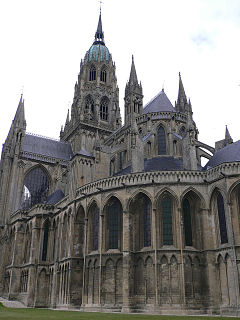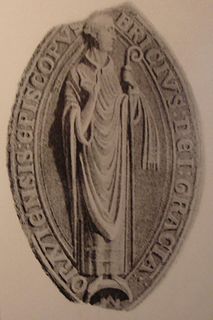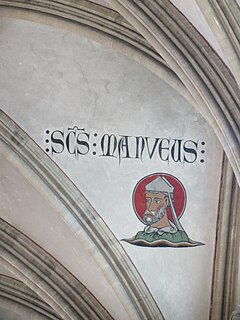
The Bayeux Tapestry is an embroidered cloth nearly 70 metres (230 ft) long and 50 centimetres (20 in) tall that depicts the events leading up to the Norman conquest of England concerning William, Duke of Normandy, and Harold, Earl of Wessex, later King of England, and culminating in the Battle of Hastings. It is thought to date to the 11th century, within a few years after the battle. It tells the story from the point of view of the conquering Normans but is now agreed to have been made in England.

Bayeux is a commune in the Calvados department in Normandy in northwestern France.

The Catholic Diocese of Honolulu, officially in Latin Diœcesis Honoluluensis, is an ecclesiastical territory or particular church of the Catholic Church in the United States. The diocese comprises the entire state of Hawaiʻi and the unincorporated Hawaiian Islands.

Thomas of Bayeux was Archbishop of York from 1070 until 1100. He was educated at Liège and became a royal chaplain to Duke William of Normandy, who later became King William I of England. After the Norman Conquest, the king nominated Thomas to succeed Ealdred as Archbishop of York. After Thomas' election, Lanfranc, Archbishop of Canterbury, demanded an oath from Thomas to obey him and any future Archbishops of Canterbury; this was part of Lanfranc's claim that Canterbury was the primary bishopric, and its holder the head of the English Church. Thomas countered that York had never made such an oath. As a result, Lanfranc refused to consecrate him. The King eventually persuaded Thomas to submit, but Thomas and Lanfranc continued to clash over ecclesiastical issues, including the primacy of Canterbury, which dioceses belonged to the province of York, and the question of how York's obedience to Canterbury would be expressed.
Thomas II was a medieval archbishop of York.

The Roman Catholic Diocese of Coutances (–Avranches) is a diocese of the Roman Catholic Church in France. Its mother church is the Cathedral of Coutance in the commune of Coutances in France. The diocese is suffragan of the Archbishop of Rouen and comprises the entire department of Manche. It was enlarged in 1802 by the addition of the former Diocese of Avranches and of two archdeaconries from the Diocese of Bayeux. Since 1854 its bishops have held the title of Bishop of Coutances (–Avranches).

The Roman Catholic Diocese of Séez is a diocese of the Roman Catholic Church in France. Originally established in the 3rd century, the diocese encompasses the department of Orne in the Region of Normandy. The episcopal see is the cathedral in Sées, and the diocese is a suffragan of the Archdiocese of Rouen.

The Roman Catholic Diocese of Bayeux and Lisieux is a diocese of the Roman Catholic Church in France. The diocese is coextensive with the Department of Calvados and is a suffragan to the Archdiocese of Rouen, which is also in Normandy.
Gilbert de Moravia, later known as Saint Gilbert of Dornoch, or Gilbert of Caithness, was the most famous Bishop of Caithness and founder of Dornoch Cathedral. His name may suggest that he came from the semi-Gaelicized family of Flemish origin who were Lords of Duffus, and who during Gilbert's episcopate would create the Earldom of Sutherland under Gilbert's possible cousin, William de Moravia, 1st Earl of Sutherland.

Bricius was prior of Lesmahagow and afterward bishop of Moray.
Saint Leontius was a bishop of Fréjus, in Provence. He was probably born at Nîmes, towards the end of the fourth century; he died in his episcopal town in 488, according to some authorities, though others say 443 or 448. His feast day is December 1.

Saint Exuperius of Bayeux (Exupère), also known as Spirius, is venerated as the first bishop of Bayeux. The date of his episcopate is given as 390 to 405, but local legends made him an immediate disciple of St. Clement, who lived during the 1st century, and that St. Regnobertus was Exuperius' disciple. This legend was found in breviaries of the 15th century. According to the Catholic Encyclopedia, “the Bollandists and M. Jules Lair found little ground for this legend; it was only towards the middle of the fourth century that St. Exuperius founded the See of Bayeux; after him the priest St. Reverendus worked to spread Christianity in these parts.” As Henry Wace writes, “this is only an instance of the tendency of the Gallic churches to claim an apostolic or subapostolic origin.”.

The Diocese of Lisieux was a Roman Catholic ecclesiastical territory in France, centered on Lisieux, in Calvados.
Saint Gonzalo, a medieval Galician nobleman and clergyman, was the long-serving Bishop of Mondoñedo from 1071. According to one modern source he was a brother of Pedro Fróilaz de Traba. If he was elected at the canonical age of thirty, he would have been born in 1040 or 1041, which would in turn support the contemporary contention that he was old in 1104–5, but cast doubt on his relationship with Pedro Fróilaz. Perhaps he was a more distant relative of the same family, the budding House of Traba.
Osbert de Bayeux was a medieval English cleric and archdeacon in the Diocese of York. A relative of Thurstan, the Archbishop of York, Osbert probably owed his ecclesiastical positions to this relative. After Thurstan's death, Osbert was opposed to one of the candidates for the archbishopric, William fitzHerbert, and worked to secure fitzHerbert's deposition and replacement by Henry Murdac. After Murdac's death in 1153, Osbert tried to prevent the return of fitzHerbert, but these attempts were unsuccessful. When fitzHerbert died suddenly in 1154, Osbert was accused of murdering the newly returned archbishop. Although he was never convicted of the murder in either a secular or an ecclesiastical court, he was stripped of his clerical status and became a layman before 1158. He died after 1184, perhaps even after 1194.

François Blouet de Camilly, Count de Saint-Pierre-sur-Dives, D.D.,, a French Catholic clergyman of the 17th and 18th Centuries, was the 88th Bishop of Toul from 1706 to 1721 and, briefly, the 117th Archbishop of Tours from 1721 to 1723.

The Priory of Plessis-Grimoult is a twelfth-century French priory built by the "Order of the Regular Canons of St. Augustine" located in Le Plessis-Grimoult in the department of Calvados. It was listed as a national heritage site in 1928, and the nearby archaeological site and the remains of the fortified garden were listed in 1996.
Loup de Bayeux, saint Loup or sometimes saint Leu was one a bishop of Bayeux towards 440-470.

St. Patrice of Bayeux (Patricius) was the sixth bishop of Bayeux in the 5th century.

Manvieu or Manveus' or sometimes Manve, Mange, Manvien, Mar-Wig, was the sixth bishop of Bayeux.














